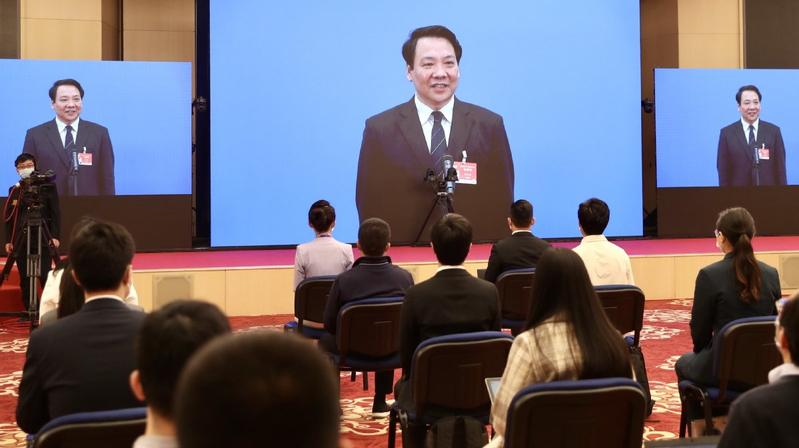 Chen Yulu, vice-governor of the People's Bank of China (PBOC), addresses reporters' queries via video link in Beijing during the two sessions on March 10, 2021. (PHOTO BY ZOU HONG / CHINA DAILY)
Chen Yulu, vice-governor of the People's Bank of China (PBOC), addresses reporters' queries via video link in Beijing during the two sessions on March 10, 2021. (PHOTO BY ZOU HONG / CHINA DAILY)
The People's Bank of China, the central bank, will not make any major policy shifts this year and will instead deploy more financial resources to support the real economy, a senior official said ahead of the official release of broad money supply and credit growth, both of which surged in February.
The PBOC said broad money supply, or M2, increased to 223.6 trillion yuan (US$34.26 trillion) by the end of February, up by 10.1 percent on a yearly basis and by 0.7 percentage point from that in January.
New yuan loans rose to 1.36 trillion yuan in February, up by 452.9 billion yuan on a yearly basis. Total social financing, which covers all types of financing to the real economy, rose by 1.71 trillion yuan, faster than expected, according to PBOC data.
This year, the digitalized services of inclusive financing will continue to develop at a fast pace, further alleviating the information asymmetry in SME financing, said Chen Yulu, vice-governor of the PBOC
Chen Yulu, vice-governor of the PBOC and a member of the 13th National Committee of the Chinese People's Political Consultative Conference, said that macro financial policies will maintain "continuity, stability and sustainability" this year.
Speaking at a news conference during the two sessions, Chen said that the policy of delaying repayment of both principal and interest on loans extended to small and micro enterprises will be extended, while large commercial banks will increase lending to SMEs by more than 30 percent.
"Small, medium-sized and micro enterprises play an irreplaceable role in the development of the economy," he said. Last year, the central bank used supportive policy tools to directly transfer funds to SMEs, including 1.8 trillion yuan in loans through the relending and rediscount facilities with lower interest rates.
Meanwhile, the PBOC adopted policies that extended the repayment of loans totaling 7.3 trillion yuan for small and micro enterprises, and issued 4 trillion yuan in fresh credit for SMEs.
ALSO READ: New system to improve SME lending
This year, the digitalized services of inclusive financing will continue to develop at a fast pace, further alleviating the information asymmetry in SME financing, he said.
Chinese monetary authorities are expected to sustain the existing policy stance this year also to avoid sharp tightening of financial conditions and prevent risks, according to experts.
Shaun Roache, chief economist for the Asia-Pacific region at Standard & Poor's Financial Services, a global credit ratings institution, said the broad message on policies is "no sharp turns" this year. "There is a tightening bias but, overall, no sense that 2021 will bring in substantial changes. Our view has been that policies had already begun tightening in the second half of 2020, as shown in a pronounced turn in financial conditions, including weaker credit flows and higher real interest rates.
"The government said it expects credit to grow in line with nominal GDP growth and total debt-to-GDP to stabilize. More efforts may be needed to constrain the debt-to-GDP ratio over the medium term," Roache said.
However, the rising inflation is likely to push up the lending rates to a certain extent and increase pressure on the PBOC, according to economists from Nomura Securities.
"But we believe Beijing will make good on its pledge to make 'no sharp shift' in its policy stance, as evidenced by the 3.2 percent fiscal deficit ratio of GDP target and the 3.65 trillion yuan quota for net local government special bond issuance announced during the ongoing National People's Congress session", said Lu Ting, chief China economist with the Tokyo-based brokerage.
READ MORE: China targets GDP growth of more than 6 percent in 2021
Lu expected no big changes in policy rates and the reserve requirement ratio in 2021. But he expects the forecast for growth of total social financing, which rose from 10.7 percent year-on-year by the end of 2019 to 13.3 percent at the end of last year, to slow gradually to around 11.5 percent by the end of this year.


